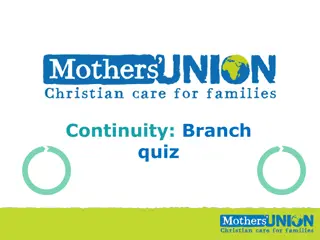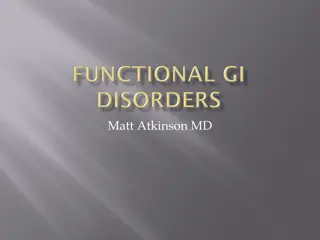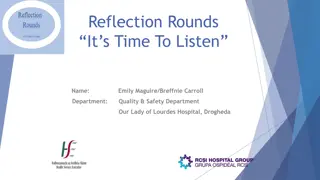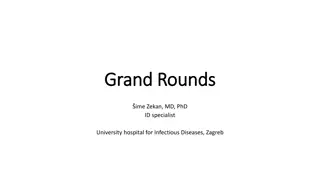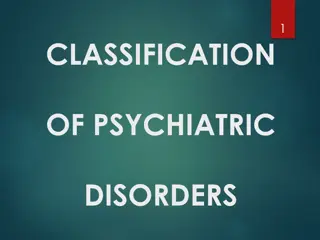Addressing Functional Somatic Disorders in Patient Safety Rounds
Explore the burden of functional somatic symptoms in NS Health, delve into emotional factors contributing to somatic symptoms, and learn about evidence-based short-term talking therapy for functional somatic disorders. Gain insights from reference materials and data on unexplained symptoms and emergency cases. Understand the challenges and approaches in managing medically unexplained symptoms as presented in Nova Scotia data.
Download Presentation

Please find below an Image/Link to download the presentation.
The content on the website is provided AS IS for your information and personal use only. It may not be sold, licensed, or shared on other websites without obtaining consent from the author.If you encounter any issues during the download, it is possible that the publisher has removed the file from their server.
You are allowed to download the files provided on this website for personal or commercial use, subject to the condition that they are used lawfully. All files are the property of their respective owners.
The content on the website is provided AS IS for your information and personal use only. It may not be sold, licensed, or shared on other websites without obtaining consent from the author.
E N D
Presentation Transcript
Addressing Functional Somatic Disorders in NS Health NSH Quality and Patient Safety Rounds 2023 Allan Abbass MD, FRCPC Professor & Program Director Centre for Emotions and Health www.istdp.ca Dalhousie University, Halifax, Canada 1
Reference Materials Reaching through Resistance: Advanced Psychotherapy Techniques Plus courses and papers www.allanabbass.com Hidden from View: A clinician s guide to Psychophysiological Disorders How to educate, provide first and second line treatments and interviewing methods. https://www.unlearnyourpain.com/hi dden_from_view_book Unlearn you Pain: H Schubiner www.unlearnyourpain.com Ted type talk on education about pain: Dr H Schubiner https://www.unlearnyourp ain.com/MS%20Lecture 2
Objectives Attendees will be able to: 1.describe the burden of functional somatic symptoms in NS Health 2.explain 4 ways emotional factors can result in somatic symptoms 3.describe the evidence base for a form of short term talking therapy in functional somatic disorders
Unexplained Symptoms in Frequent Attenders Reid et al, BMJ 2001 Specialty % of visits with no physical findings 54 50 34 33 30 27 17 17 Gastroenterology Neurology Cardiology Rheumatology Orthopedics ENT Gynecology General Surgery
Emergency Data : NS Health Chest Pain, Headache, Panic, Abdominal Pain NYD account for 20% or over 20000 of all CDHA ED Visits each year Abbass Campbell Magee and Tarzwell, 2009 88% of all Abdominal Pain complaints come out with no diagnosis: 3300 visits 75% of all Chest Pain complaints come out with no diagnosis: 4100 visits
Nova Scotia Data: Medically Unexplained Symptoms 17816 days 1167 admissions 11956 days 842 admissions 91942 days 4898 admissions 15275 days 983 admissions Over 130,000 Days
Figure 1: Overlap of Somatic Symptom Presentations NS Data N=890 Centre for Emotions and Health Referred patients Irritable Bowel Syndrome Other GI Fibromyalgia Urinary Migraine Conversion Disorder Abbass et al, Journal of Psychiatry Research, 2015
What causes these symptoms and how to address them? Conscious fear caused by innocuous symptom: fear makes more symptoms Avoidance makes more symptoms and fear Nervous doctors create more symptoms Unconscious Processes: Unresolved Mixed feelings of love and rage with the same person Makes somatic symptoms in very specific formats Makes interpersonal problems with the health system, providers, employers and staff admissions can make this all worse
Intensive Short-term Dynamic Psychotherapy Evidence in Functional Somatic Disorders 25+ published outcome studies for somatic disorders Urethral Syndrome/ Pelvic Pain, Back Pain, Functional Movement Disorders, Chronic Headache, Pseudoseizures, Chronic Pain (7 RCTs) Irritable Bowel Syndrome, Mixed MUS (2 studies), Atopic Dermatitis, Bruxism, Functional Neurological Disorders, Inflammatory Bowel Dis Effects are sustained or increase in follow-up (Town and Driessen 2013, Abbass et al 2020, 2021) Outperforms CBT and MBSR for Chronic Pain (Abbass 2023) Good evidence for cost reduction and health service reduction (25 studies)
Condition Study Type RCT Case Series Case Series Case Series Case Series Case Series RCT RCT RCT RCT Controlled Controlled RCT RCT Case Series n Outcome 36 29 47 9 29 28 63 81 100 102 77 890 32 41 11 37 7 67 341 228 64 230 106 36 30 18 ISTDP > Medical TAU Sig symptom reduction Sig pain reduction Sig symptom reduction Sig symptom and healthcare cost reduction Sig symptom and cost reduction ISTDP> Mindfulness Based Stress Reduction /TAU ISTDP in person > ISTDP by Skype ISTDP by Skype > TAU ISTDP > Medical TAU Sig symptom and emergency visit reduction vs control Sig symptom reduction and Health Cost reduction ISTDP> control in anxious Cases ISTDP> control Improvement on multiple domains Sig symptom improvement Improvement on IBD symptoms Sig symptom reduction Sig symptom effects ISTDP=CBT Symptom reduction and healthcare cost reduction ISTDP+EAET>CBT EAET> or equal to CBT EAET > Structured Relaxation ISTDP> MBSR, Control ISTDP> Control Reduced symptoms, long term health cost reductions Urethral Syndrome/ Pelvic Pain (1) Mixed MUS (2) Back Pain (3) Functional Movement Disorders (4) Chronic Headache (5) Pseudoseizures (6) Chronic Pain (7) Chronic Pain (8) Chronic Pain (9) Irritable Bowel Syndrome (10) MUS in Emergency (11) Mixed MUS + (12) Atopic Dermatitis (13) Bruxism (14) Functional Neurological (15) Mixed Somatic Symptoms in Family Practice (16) Case Series Inflammatory Bowel Disease (IBD)* (17) Fibromyalgia (18) Chronic Pain (19) Chronic Pain (20) Chronic Pain in Veterans ** (21) Chronic Pain*** (22) Irritable Bowel Syndrome ***(23) Fibromyalgia (24, 25) Irritable Bowel Syndrome (26, 27) Functional Seizures (28, 29) Case Series Case Series RCT Case Series RCT RCT RCT RCT RCT Case Series
ISTDP for Unexplained Symptoms in the Emergency Department ED visits before vs after ISTDP Treatment 7 6.5 p =0.23 6 ED visits/ patient/ year 5 4.6 4 p<.01 ISTDP Controls 3 p <.001 2 1.4 1 0 Pre Post Abbass, Campbell et al, 2009, 2010a and b
ISTDP for Pseudoseizures Population Norm Russell, Abbass, Allder, Pohlman-Eden, Kisely, Town, 2016 Allan Abbass MD, 2021
ISTDP for Chronic Pain Total Hospital and Doctor Costs 8000 7000 6000 5000 4000 3000 Population Norm 2000 1000 0 1 year pre 1 year post 2 year post 3 year post Lilliengren, Cooper, Town, Kisely, Abbass, 2020
Physician and Hospital Costs Pre and Post ISTDP. Irritable Bowel Syndrome Patients 1998-2007 4500 4000 3500 3000 2500 2000 Nova Scotia/Canadian Mean 1500 1000 500 0 1 yr pre 1 yr post 2 yr post 3 yr post 4 yr post
NSHealth Employees with excess work loss and disability due to somatic symptoms 18 Employees Average of 7.5 visits 87% of employees involved in treatment assessment were successfully (maintained return to work greater than 3 months) returned to work Net Cost Saving for NSHealth of $240,000 over 2 years follow-up ($13,300/ employee)
BOND With Parents FEAR PAIN Rage, Guilt about the Rage Symptoms Self-destruct Fear closeness
Current Person Doctor, Boss, Spouse = Transference. Normal process we all do Past Person Example: Buried mixed feelings with Father, Mother, Sibling, Abuser
Unconscious defense Unconscious Anxiety Striated muscle Smooth muscle Cognitive perceptual Muscle paralysis Unconscious impulses and feelings
Voluntary Muscle Pathway Hands Clench Arms Shoulders, Neck Intercostal: Sighs Legs and Feet Fibromyalgia, Headache, chest pain, Tremor, spasm, Tics, TMJ pain Shortness of breath, hyperventilation, panic Can Intellectualize about feelings but don t feel the feelings
Experiencing the feelings: overrides the symptoms Rage: Upward heat or energy sensation. From feet up to neck then down arms Urge to grab and do some form of violence Guilt: Chest constriction and pain with thoughts of remorse. Grief: pain with thoughts of loss, tears, longing for the lost person. Love: warm sensation expansion in chest, urge to embrace Vast majority of health providers can t tell an emotion from anxiety
Inhibitory Forces go Down Somatic Pathway of rage goes Up same system AMA Atlas online
Smooth Muscle Gastrointestinal Migraine Coronary Arteries Bronchi Bladder -> Acute or chronic spasm and pain plus end organ effects Patient looks relaxed = Not Tense in Striated Muscle Can t intellectualize about feelings: they disappear into the body
Motor Conversion Functional weakness in the body in one or more areas. When conversion is active, there is no unconscious anxiety in the voluntary muscles When treated, anxiety returns to striated muscles and feelings can be safely felt
Cognitive-perceptual Disruption Losing track of thoughts, poor memory, Visual blurring, tunnel vision, blindness Ears ringing, Loss of hearing Hallucination in all 5 senses Anesthesia, paresthesia Depersonalization, Derealization, Dissociation Pseudoseizures and fainting
Sympathy symptoms: source of odd symptoms Patient feels what the rage wanted to do to others in his own body Strangling rage: choking symptoms Crush the chest: crushing chest pain Stab the head: stabbing headache Remove by feeling the guilt about the rage
Proposal under consideration with Medicine Leadership to reduce bed use Bolster Emergency department staff including more same day service to prevent admissions Liaise with med surgical specialties to prevent admissions in cases of acute or chronic symptoms Rapid access to early admitted patients with unexplained symptoms: liaised with CL psychiatry Education to specialties on symptoms and how to refer 2 FTE Psychologist and 0.5 Psychiatrist






